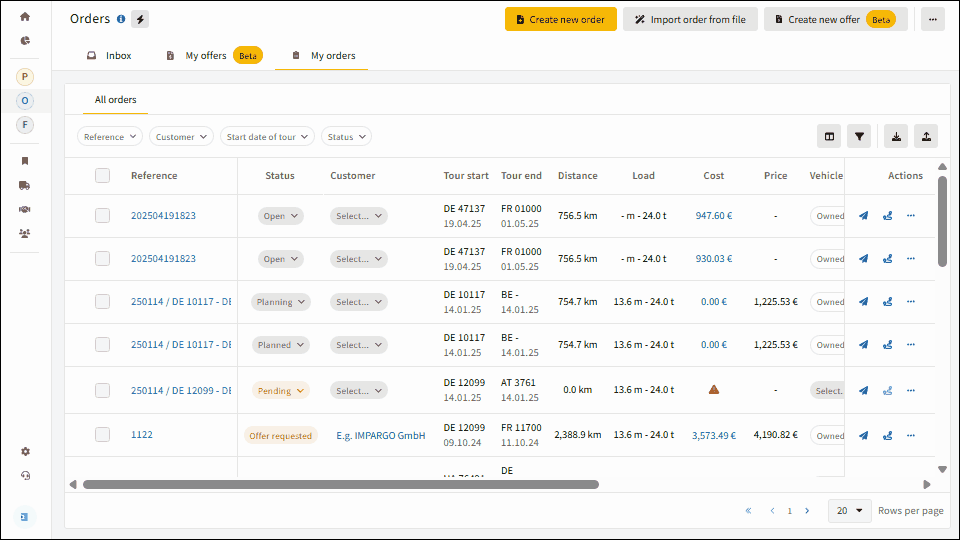AI in transportation and logistics is no longer a distant trend. From order entry to tariff management, companies are already realizing the benefits of AI in logistics: faster workflows, fewer errors, and the ability to scale from 5,000 to 25,000+ orders without additional staff. With AI-powered dispatching, the logistics industry is entering a new era of efficiency and reliability.
Table of Contents
- Status Quo: Manual and Semi-Digital Workflows Still Dominate
- Benefits of AI in Logistics: Efficiency and Scalability
- Manual vs. AI in Logistics Optimization: Direct Comparison
- AI in Logistics Examples: Practical Use Cases and Savings
- AI-Powered TMS: Why IMPARGO Leads in Transportation Logistics
- FAQ: How AI Is Used in Logistics Today
Status Quo: Manual and Semi-Digital Workflows Still Dominate
Despite digital adoption, many companies in the logistics industry still operate on outdated processes:
- Spreadsheets & phone calls dominate dispatching
- Even modern TMS platforms require manual data entry from PDFs
- Each transport order takes 3–5 minutes to process
- Manual input produces 3–8% error rates
Scaling from 10,000 to 25,000+ orders annually becomes impossible without hiring.
Benefits of AI in Logistics: Efficiency and Scalability
The use of AI in logistics provides measurable business impact such as:
- Automated extraction of transport orders from emails/PDFs
- Duplicate detection and error prevention
- Real-time route & tariff optimization
- Semi-automated responses to customer inquiries
- Significant reductions in admin costs
AI in logistics operations builds on digital tools, enabling teams to scale efficiently without increasing headcount.
Manual vs. AI in Logistics Optimization: Direct Comparison
Use Case: Transport Order Entry in a TMS
One of the clearest AI use cases in logistics is automated TMS data entry. Today, dispatchers manually copy data from PDFs or emails — a repetitive, error-prone task.
AI-powered import automatically reads and structures order data for dispatcher review.This is AI in logistics optimization in practice: higher speed, lower costs, fewer errors.
Metric | Manual Data Entry (TMS) | AI-Powered Data Entry (IMPARGO TMP®) |
| Avg. Time per Order | ~5 minutes | ~30 seconds |
| Error Rate | 3–8% (typos, omissions) | <0.5% (OCR/AI misreads) |
| Cost per 1,000 Orders | €600–€1,000 | €60–€120 |
| Orders per Dispatcher/Day | 80–100 | 500–1,000 |
| Integration | Manual handoff | Seamless automation |
| Payback Period | N/A | <3 months |

AI in Logistics Examples: Practical Use Cases and Savings
For those asking how AI is used in logistics or what is an example of AI in logistics, here are proven applications:
- PDF Transport Order Import → Saves 2–4 minutes/order → €6,660–€13,320 saved annually (10,000 orders).
- Tariff Read-Out & Rate Management → AI structures individual rate sheets and suggests optimal tariffs, improving margins.
- Duplicate Detection → Prevents duplicate/outdated bookings, reducing disputes.
- Semi-Automated Email Handling → Drafts responses to routine questions (“Where is my shipment?”) for dispatcher approval.
These examples of AI in logistics show ROI that companies can measure from day one.
AI-Powered TMS: Why IMPARGO Leads in Transportation Logistics
To unlock the use of AI in logistics, a future-ready TMS is essential.
IMPARGO TMP® is built for automation and scalability:
- AI-powered order import (live today)
- No IT integration required
- Cloud-native, always updated
- Modular pricing for flexible growth
- Trusted by 2,000+ companies across Europe
Outcome: scale from 5,000 → 25,000+ orders annually without hiring more staff.

FAQ: How AI Is Used in Logistics Today
Q1. How is AI used in logistics?
AI is used for automated order entry, duplicate detection, tariff management, and customer communication.
Q2. What is an example of AI in logistics?
A clear example is AI-powered PDF import, which reduces processing time from 5 minutes to 30 seconds.
Q3. What are the benefits of AI in logistics?
Cost savings, faster workflows, fewer errors, and scalability without extra staff.
Q4. How to use AI in logistics effectively?
Adopt a modern cloud-based TMS like IMPARGO TMP® and enable AI features for order import, rate handling, and automated workflows.

